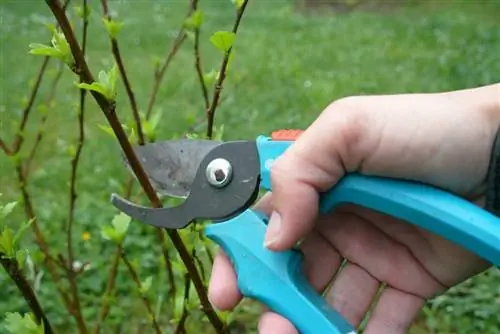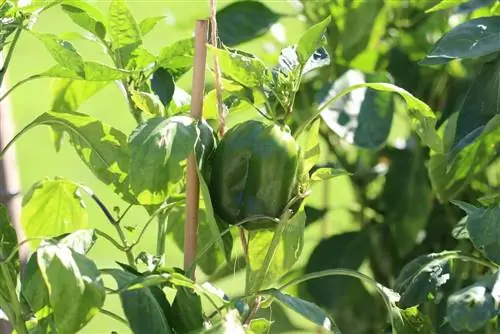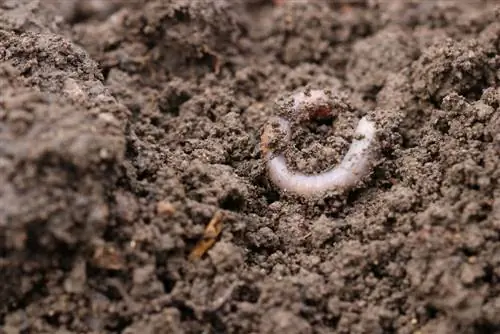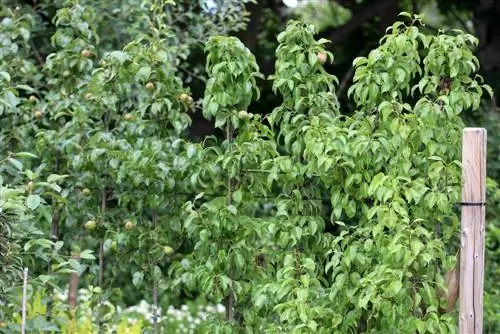- Author admin [email protected].
- Public 2023-12-17 03:39.
- Last modified 2025-01-24 12:45.
Pruning plants regularly ensures long-term he althy growth, magnificent flowers and can increase the harvest of fruit-bearing plants. However, the right time when pruning is extremely important, otherwise the plant can be damaged or freeze to death next winter due to a weakened immune system. Some plants only need to be removed from dead and dead areas, others need radical pruning. The flowering time of the respective plant provides a crucial indication of the timing and extent of pruning.
Plant pruning tips
Many gardeners shy away from pruning plants because they don't know exactly when and where to cut. Pruning is extremely important for most plants in order to ensure long-term, he althy growth, to produce magnificent flowers and not to go bald prematurely. In addition, the harvest yields of fruit-bearing plants can be increased with targeted pruning. Although there are no generally applicable instructions for pruning plants, certain basic rules can be laid down. If you want to be on the safe side, you should find out exactly about the requirements of the respective plant in advance:
- Cut out faded and dead plant parts regularly
- Thin out shoots that are too branched to prevent harmful fungal infestation
- Cut bushes regularly, otherwise they will develop shoots that are too long and thin
- In general, early bloomers should be pruned immediately after flowering
- Do not cut late bloomers until next spring
- If in doubt, do not trim the plant, just thin it out
- Prune strong growing hedges twice a year
- Double pruning promotes denser privacy, e.g. B. for flowering trees and privet hedges
- The more severe the pruning, the more new shoots will be formed
- Prune strong shoots only lightly, but weak shoots heavily
- Prune only in warm and dry weather conditions
Tip:
If bleeding cuts occur during pruning, these must be closed with a wound closure agent. Always make sure you use high-quality tools; only sharp and disinfected secateurs enable a clean cut.
Spring
The plants that bloom in spring bloom on a previous year's shoot; the stronger it is, the richer the flowering. Many flowering ornamental plants need to be pruned in spring because these cuts can no longer close at the end of the growing season. If the cut is carried out too late in autumn, frost can penetrate the plant unhindered and even cause it to die. In spring, during the growing season, plants recover more quickly from pruning. This way, harmful pathogens cannot enter the cuts and infect the plant. A disadvantage, however, are the bare spots, which are often visible throughout the summer months. The following aspects should be taken into account when pruning plants in spring:
- Prune roses generally only in spring, definitely not in late autumn
- Early spring is the ideal time for pruning summer-flowering fruit trees
- Always prune fruit trees before budding begins, otherwise they will bleed
- Pruning raspberries for the first time in spring
- Prune bushes that only bloom in late summer and winter
- Evergreen grasses, e.g. B. Waldmarbel, clean out in spring
- Pruning the ornamental grasses, their fruit heads beautify the bare garden in winter
- Fruits of ornamental grasses also serve as bird food and winter protection
- Cut back frost-related damage to small-flowered plants completely
Tip:
A radical pruning in spring results in only a few new shoots, but very strong ones. The smaller the pruning, the more new shoots will form.
Summer
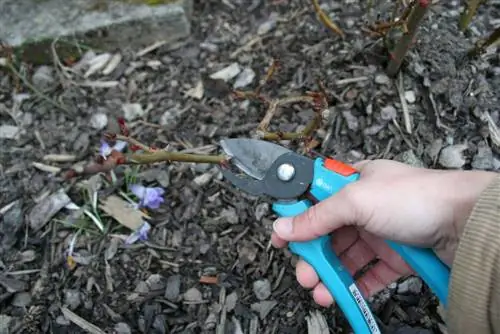
In summer, plant pruning should be divided into periods and, depending on the plants, carried out either at the beginning of summer, in mid-summer or in late summer. The plants that bloom in spring should also be cleaned out at this time, especially during rainy periods, so that the rotting flowers do not lead to fungal infestation. The summer bloomers bear their flowers on this year's shoots. Summer pruning is more about maintaining the shape; radical pruning should not be done during this time of year. The following procedures have proven to be effective when pruning plants in summer:
- Pruning flowering shrubs at the beginning of summer
- For red gooseberries and currants, start pruning in mid-summer
- Cut fan espaliers and walking trellises into shape in late summer
- Pruning plums and raspberries after the summer harvest
- Cut hedges that serve as privacy screens
- Do not prune sensitive hedges from August onwards, as young new shoots can easily freeze to death
- Cut back spring perennials when the leaves turn yellow, e.g. B. Bleeding Heart
- Spring perennials move in early for oversummer
- For summer perennials, remove the dead inflorescences in good time
- Summer perennials then bloom again in autumn, especially the delphinium
- Prune deciduous trees, such as forsythia and lilac, after flowering in early summer
- Pruning cherry trees, peaches and apricots in late summer
- Cut off branches and fruits intended for thinning to simplify harvesting
- After the harvest, make a rejuvenation cut and thin out the crown
Tip:
For flowering shrubs, the time of flowering can be controlled by pruning, and in some cases the plant can even be made to bloom again.
Autumn
In autumn, plant pruning should be carried out less radically so that the plant does not have to suffer unnecessarily in the upcoming winter. The leaves, flowers and stalks left standing serve as additional protection against frosty temperatures and prevent external shoots from freezing. The autumn bloomers, like the summer bloomers, have their flowers on this year's shoots. Pruning in autumn is particularly recommended in rough and windy altitudes when a lot of snow is expected in winter:
- In autumn, most plants are already in the dormant phase
- Bleeding during cutting is less
- Pruning late fruiting plum trees
- Cleaning out late-blooming floribunda roses
- Shaping blackberries after harvesting
- Blackberry shoots grow from the leaf axils, cut them back
- Cut back summer green grasses in autumn
Tip:
Pruning in autumn should not be carried out on pampas grass and other frost-sensitive grasses; these are better tied together in late autumn.
Winter
Most plants should not be pruned in winter, as pruning can cause frostbite and, in extreme cases, even cause the plants to die. Only a few hardy varieties can handle pruning in the cold season without causing damage. It is said that fruit trees are pruned in winter because the workload of the farmers was too great during the other season and they only had time for it in the winter:
- Only prune extremely hardy trees and shrubs
- It's better to avoid pruning during the winter
- Traditionally, fruit trees are cut in winter
Conclusion
Pruning is crucial for the plant to develop magnificently; if this part of gardening is neglected, the growth and development of the flowers will suffer. Many shrubs become woody and bald over time if they are not pruned regularly. Basically, early spring and late fall are the best times of year to prune plants. However, pruning should be less extreme in autumn, but it can be a little more radical in spring. The flowering time is a significant indication when determining the right time to prune the plant. Early-flowering plants are pruned immediately after flowering, late-flowering varieties only in the following spring. Deciduous trees and shrubs that grow too dense and tangled over the years should generally be thinned out. A targeted plant cut promotes air circulation between the branches and leaves, thereby sustainably preventing fungal infestation.

